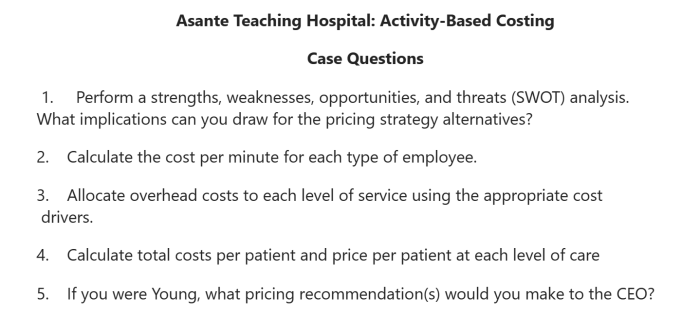Asante teaching hospital activity-based costing – Asante Teaching Hospital’s Activity-Based Costing (ABC) system stands as a testament to the transformative power of data-driven decision-making in healthcare. By meticulously tracking and allocating costs across activities, departments, and services, Asante has gained unprecedented insights into its operations, leading to optimized resource allocation, enhanced service pricing, and a surge in operational efficiency.
The ABC system’s rigorous methodology has enabled Asante to pinpoint inefficiencies, streamline processes, and identify areas for cost reduction. This granular understanding of costs has empowered the hospital’s leadership to make informed decisions, ensuring the delivery of high-quality patient care while maintaining financial sustainability.
Overview of Asante Teaching Hospital Activity-Based Costing System

Asante Teaching Hospital implemented an activity-based costing (ABC) system to improve resource allocation, service pricing, and operational efficiency. ABC is a costing method that assigns costs to activities and then allocates those costs to products or services based on the activities consumed.
The ABC system at Asante Teaching Hospital is based on the following principles:
- Activities are the fundamental units of work performed within the hospital.
- Costs are assigned to activities based on the resources consumed by each activity.
- Costs are allocated from activities to departments and services based on the activities performed by each department or service.
Activity Analysis and Cost Assignment
Asante Teaching Hospital identified over 100 activities performed within the hospital, including patient care, administrative support, and facility maintenance. The costs associated with each activity were determined using a combination of time studies, interviews with staff, and historical data.
Once the costs of each activity were determined, they were assigned to activities using a variety of methods, including:
- Direct tracing: Costs that can be directly traced to an activity are assigned to that activity.
- Indirect allocation: Costs that cannot be directly traced to an activity are allocated based on a reasonable and consistent method, such as the number of employees in a department or the square footage of a facility.
Cost Allocation to Departments and Services
Costs are allocated from activities to departments and services based on the activities performed by each department or service. For example, the cost of the patient care activity is allocated to the inpatient department based on the number of patient days in the department.
Asante Teaching Hospital uses a variety of allocation methods, including:
- Activity-based allocation: Costs are allocated based on the actual level of activity performed by each department or service.
- Simple allocation: Costs are allocated based on a simple measure of activity, such as the number of employees in a department or the square footage of a facility.
Impact on Decision-Making, Asante teaching hospital activity-based costing
The ABC system at Asante Teaching Hospital has had a significant impact on decision-making within the hospital. For example, the system has been used to:
- Identify cost drivers and reduce costs.
- Improve resource allocation by directing resources to the most profitable activities.
- Set prices for services based on their true cost.
Challenges and Limitations
Implementing an ABC system can be challenging and time-consuming. Some of the challenges associated with ABC include:
- Identifying and measuring activities.
- Assigning costs to activities.
- Allocating costs from activities to departments and services.
Despite these challenges, ABC can be a valuable tool for healthcare organizations. By providing more accurate information about the cost of activities and services, ABC can help organizations make better decisions about resource allocation, service pricing, and operational efficiency.
Popular Questions: Asante Teaching Hospital Activity-based Costing
What are the key benefits of implementing an Activity-Based Costing system?
ABC systems provide hospitals with a detailed understanding of their cost structure, enabling them to identify inefficiencies, optimize resource allocation, and make informed decisions.
How does ABC differ from traditional costing methods?
Unlike traditional methods that allocate costs based on volume or direct labor hours, ABC assigns costs based on the activities that consume resources, providing a more accurate picture of cost drivers.
What are the challenges associated with implementing an ABC system?
Implementing an ABC system requires significant time, effort, and data collection. Additionally, ongoing maintenance and refinement are necessary to ensure the system remains accurate and relevant.


